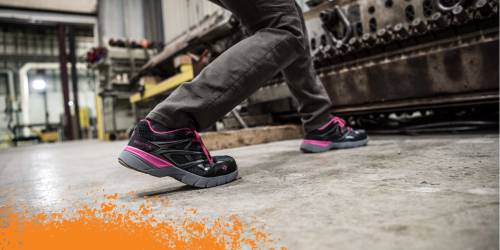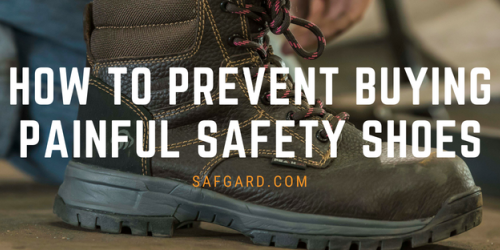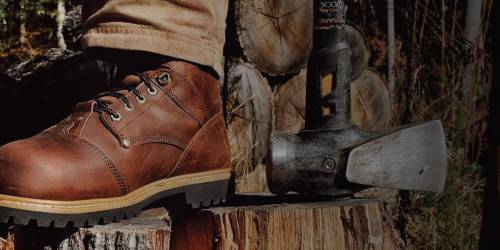06/15/2023
How do you find the perfect fitting safety toe boot?

I’ll never forget my first incredibly uncomfortable pair of safety toe boots. I was just beginning my career as a Repair Technician for a phone and internet provider, and the job was tough and sometimes dangerous. We worked in all weather, rain or shine, snow or blistering heat. Sometimes we’d spend half the day on our bellies running wires through customers' crawl spaces, and the next day we’d find ourselves splicing copper cables 20 feet off the ground in aerial terminals. With a job this physically demanding, the last thing you want to think about is your feet.
Unfortunately for me, my feet hurt like crazy at the end of my first day. By lunchtime my toes ached from constantly bumping up against the safety toe cap. You might be saying to yourself that I was just unlucky and got a bad pair of boots. But my boots weren’t the problem; the problem was that I didn’t pick the right pair for my feet. It’s simple. Not all shoes are the same because not all feet are the same. Lesson learned.
At Saf-Gard we believe sharing the right knowledge will enable you to get the most comfortable safety shoes you can find, ones that’ll outlast your toughest days. The good news? You don’t have to discover this stuff the hard way.
To get a perfect fitting pair of safety toe boots every time, here are the top FOUR things I wish I’d known before my first day on the job.
- Give yourself some wiggle room. A safety toe boot that fits properly allows space between your toes and the toe cap. In fact, your big toe should be about halfway under, and your pinky toe should rest just behind the toe cap when standing. In other words, the top cap is only intended to cover the first four toes. This will give you both the protective benefits of the boot and prevent your feet from feeling cramped.
Another method to help ensure proper toe clearance is one that runners and hikers often use. When trying on your boots, try to make your toes touch the tip of the toe cap. If you can do it, your boots are likely too small. You’ll find that a long workday with your toes rubbing or pressing against the toe cap will cause a considerable amount of foot pain. It can even damage your nail bed.
- Make sure the heels fit snugly. If your toes have plenty of breathing room, but your heels are flopping around, your boots are too big. The trick is to find the happy medium: plenty of room for your toes but not so much that you end up with a loose fit. This is not only important for comfort, but also for safety. A loose boot probably isn’t offering much toe protection, and it’s just as likely to disrupt your normal gate as tight-fitting boots. That just puts you at greater risk for tripping and falling. So, make sure you find that balance.
- Shop for your foot width. If a boot is too tight around your foot’s midsection, you’re in for a world of pain. It might start out as just a bit of discomfort, but in a short time you’ll likely develop blisters. It’s true that the sides of your feet should touch the sides of your boots, but the keyword here is touch. In other words, you shouldn’t feel any pressure or squeezing.
Although every foot is different, the average person will need a medium width boot. Usually labeled “D,” “M” or “Reg,” medium width footwear is what you’ll find at the typical shoe store. But what do you do if you have no idea what width you need? The easiest solution is to test out a medium width pair and then adjust your sizing accordingly. Use the chart below as a guide. Just know that there’s about a ⅕” difference between each width.
| Shoe Width | Men’s | Women’s |
| Extra Narrow | A | 4A / AAAA |
| Narrow | B / N | 2A / AA |
| Narrow Medium | C |
|
| Medium (most common) | D / M / Reg | B / M |
| Medium Wide | E / MW | C |
| Wide | EE / W | D / W |
| Extra Wide | EEE / EW / WW / XW | 2E / EE / WW / XW / EW |
| 2X Wide | EEEE |
|
| 3X Wide | 5E |
|
| 4X Wide | 6E |
|
- Every foot is unique. What works for your coworker may not work for you. That’s why many of our Saf-Gard retail stores are equipped with Aetrex foot scanners (Hyperlink to Aetrex page). This technology captures data like foot length, width, instep and arch height as well as pressure points. It does all this in under 20 seconds, then makes recommendations based on your feet to help get you the perfect fitting safety shoes and insoles. You shouldn’t have to settle for uncomfortable safety footwear, and you really don’t have to.
There you have it. Follow these four rules of thumb, and you’re almost guaranteed to score an incredibly comfortable pair of safety toe boots. Just remember that everything has a shelf life. Your boots will wear down over time. So, to keep that comfort level at an all-time high, we recommend replacing your boots at least once per year or, for those extra strenuous work conditions, every six months.
When I first began my career as a Repair Tech, I never would’ve guessed so much goes into finding the perfect fitting safety toe boot. But boy is it worth the extra effort because getting comfortable boots, and I mean the all-day-wear kind of comfortable, is an absolute game changer.
Boot Comfort Checklist
● Big toe is halfway under the toe cap and has plenty of wiggle room.
● Heel stays in place. Not sliding around.
● Foot’s midsection touches the boot but doesn’t feel pressure.
● Plan to replace them when worn out or at least once per year. Replace every six months for tough environments.
Looking for some insanely comfortable safety toe boots?
Want to learn how our straightforward, custom shoe programs can help you reduce employee risk?
Categories: Safety Tips | Authored by: Bryan McMillan, Saf-Gard Marketing Department | Posted: 06/15/2023











